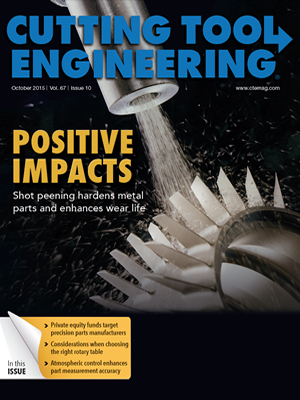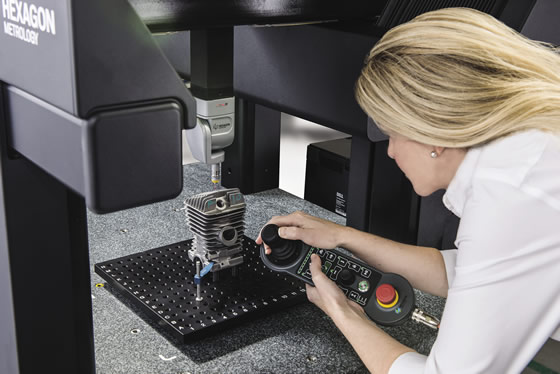
Image courtesy Hexagon Metrology.

As children, we likely all learned the hard way that drastic temperature changes cause objects to change size—whether it was leaving a soda in the freezer too long to get it cold or breaking your turtle’s terrarium by cleaning it with hot water after it had been resting on the cold ground (sorry, Mom and Dad!).
However, in the realm of precision measurement, even minute differences in atmospheric conditions can have huge impacts—to the point that parts manufactured within spec can fail inspection and be needlessly reworked or even scrapped.
According to the paper “Coordinate Measuring Machine Accuracy on the Shop Floor: The Value of Continuous Thermal Specifications” by Eric Bennet and Wim Weekers of Hexagon Metrology Inc., North Kingston, R.I., changes in temperature can cause the scales, machine structure and workpieces being measured to expand, contract or even distort.
“Though often compensated for in a variety of ways, these thermally induced changes can lead to significant measurement uncertainty, particularly in the context of measurement on the shop floor, where temperature can be difficult to control,” they stated. “With the ever-continuing trend of moving dimensional inspection from thermally controlled metrology labs to the shop floor, understanding how temperature affects CMM accuracy is more important than ever before.
“Traditionally, the thermal dependence of a CMM’s accuracy has been specified using broad temperature bands centered about 20° C (68° F). For instance, a manufacturer might specify a hypothetical CMM’s maximum permissible error of indication for size measurement, MPEE, according to ISO 10360-2 over a temperature band of 18° to 22° C (64° to 72° F) as:
- MPEE (µm)= 3.0 + 3.0 × L ÷ 1,000,
- where L is the measurement length in millimeters.
“While this is a logical way for both the CMM manufacturer and the customer to specify the temperature dependence of CMM accuracy for a machine in a lab environment, the logic falls apart for machines installed and used in an environment where the temperature is not well controlled over both long and short time scales.
“To avoid these measurement errors, shops must be able to control and monitor the atmosphere surrounding the measurement device. Typically, this is done using specially designed rooms, air sensors and software programmed to detect fluctuations.”
So, how can a shop control and monitor the atmosphere?
The Room
In a perfect world, measurement equipment would be enclosed in a controlled bubble, where temperature and humidity remain completely static at all times. In the world we inhabit, however, specially constructed measurement rooms can approach that ideal.
“Temperature and humidity control are the most important design criteria, because temperature stabilizes the part piece and the instruments making the measurement,” said Doug Cooper, president of controlled environment builders Precision Environments Inc., West Chester, Ohio. “There’s a coefficient of expansion of the materials, and when you have temperature fluctuations, materials will expand and contract along with them.”

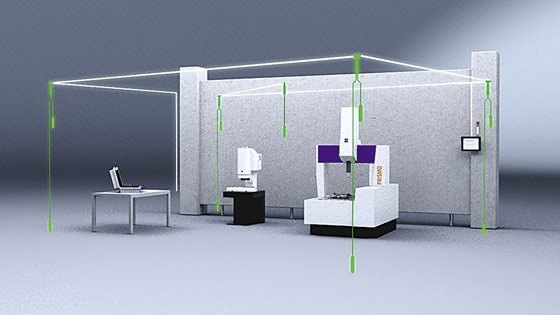
The TEMPAR system by Zeiss utilizes an array of sensors (below) distributed throughout the room to accurately measure atmospheric conditions. Images courtesy Carl Zeiss Industrial Metrology.
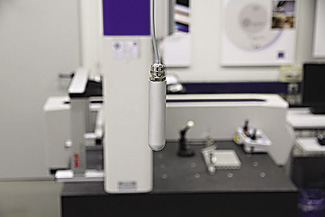

To achieve this, Precision Environments constructs custom rooms equipped with dedicated heating, ventilation and air-conditioning systems to maintain atmospheric consistency, and special features to allow a high air exchange rate at a low air velocity. The room, which can range from 100 to 9,000 sq. ft., with ceiling heights from 9 ' to 40 ', is essentially a box with a roof. The plenum—the space between the roof and the perforated ceiling—is pressurized by the HVAC unit, which forces new air through the perforations, while old air is returned through a wall vent close to the ground. This high rate of exchange ensures atmospheric specifications are being met, according to the company.
“The international standard temperature set point is 20° C,” Cooper noted. “State-of-the-art temperature control for very high measurement accuracy is ±0.01° C, while temperature control for standard industrial manufacturing is usually ±1° C. Humidity is also a major concern, as corrosion can occur at over 50 percent RH (relative humidity), so in typical manufacturing environments, specifications are 45 percent, ±5 percent RH.”
Another reason humidity is important is because many CMMs have granite tables. Granite is hygroscopic, meaning it attracts and holds water molecules from the environment. “Granite will actually change its geometry with fluctuations in humidity,” Cooper said.
In addition, the rooms are rated to ISO 8 or better in terms of air cleanliness, not high enough to certify the space as a “clean room,” but offering enough filtering capability to prevent particulates from affecting the measurement process.
However, adding one of these rooms is no small task. First, Cooper said, the shop must have enough space, horizontally and vertically, for the desired room size, as well as for the HVAC unit. Then, Precision Environments’ customers complete a lab planning guide questionnaire, answering questions about doors, windows, temperature specifications, electricity requirements and other existing features. This information gives Precision Environments a sense of what it has to work with by way of shop infrastructure. A budget is developed and submitted for approval, followed by a site visit. Once engineering drawings and an equipment manifest is approved, the actual construction can begin.
“From the time materials arrive up until the certification process, we have a site superintendent heading up the project,” Cooper said, “and once installation is completed, we have specially trained technicians come in to start the HVAC, balance the room to ensure proper temperature, humidity and gradient control, and then we certify the room.”
Air-ly Detection
So, once you’ve got a room set up and certified, how do you ensure the atmospheric conditions aren’t compromised? Fortunately, many basic measurement software suites enable programming to detect and accommodate for atmospheric fluctuations.
“We use a basic air-temperature sensor, which senses things like humidity, barometric pressure and air temperature,” said Sean Leonard, product integration engineer for software provider Verisurf Software Inc., Anaheim, Calif., “We’ll take those factors [into consideration] when recording measurements regardless of the device type. Whether it’s a laser tracker, a CMM or portable CMM, we’re accounting for the temperature conditions on both the device and the air around it. We also use an external probe to measure the temperature of parts.”
Once the software has recorded the information, Leonard explained that users can select the material type from a list of more than 20 different options and the software will calculate the appropriate coefficient and update the results. The software also features a drift alarm, which generates a pop-up message and won’t allow measurements to be taken if the temperature fluctuates outside a user-specified parameter.

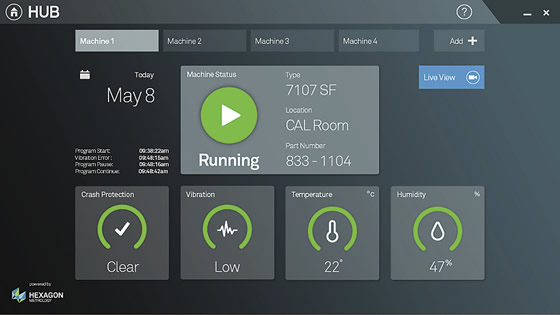
Hexagon Metrology’s MMS Pulse system offers a central dashboard to display variations in temperature, vibration and humidity, which operators can access at any time. Image courtesy Hexagon Metrology.

“It doesn’t really get any simpler or easier than that,” he said.
In addition to basic air-temperature sensors, new systems, such as TEMPAR from Carl Zeiss Industrial Metrology, Maple Grove, Minn., offer an array of sensors to be deployed around a metrology lab, giving a comprehensive picture of its atmosphere.
“Think of a security system for your home,” said Zeiss product manager David Wick. “A security system monitors all of your windows and doors and lets you know if anything goes wrong. TEMPAR tracks and records temperature and humidity and how they change over time, and lets you know if something goes out of spec. It can display the information on a computer screen, it can send you an email or text message, or you can check the readings via remote web access. It’s like a security system for your measuring room.”
Within the typical range of 15° to 30° C, precision CMMs are spec’d so the room temperature can vary 1° C per meter, Wick said. “Essentially, that means the temperature at the very edge of the room has to be within 1° C of the temperature when you take one step into the room. We use these tight tolerances because performance-measurement equipment is extremely precise, and it is absolutely essential to ensure your measuring room stays in spec throughout the measurement process.”
The entry-level TEMPAR system includes eight sensors and a touchscreen-equipped computing node, which operators can use to view and interact with the readings. More expensive packages offer more sensors and additional functionality, such as a mobile workstation that can be moved around the room or connectivity using Zeiss’s PiWEB software protocol.
“PiWEB is a quality data-management protocol that ties together all Zeiss equipment,” Wick explained. “If you’ve got any number of Zeiss machines at different locations all over the country, using the PiWeb software, you can monitor all of those machines from one location. On top of that, TEMPAR lets you remotely see what the measuring-room temperature and conditions are for each machine.”
Additionally, some TEMPAR packages offer a perk called “measuring room class in real time.” This is software that takes the sensor input data and turns it into a classification for the atmosphere inside the room using ISO definitions, Wick said. Also, all measurements are recorded as a function of time, meaning that some errors can be identified as a result of temperature fluctuations, avoiding unnecessary rework.
Frequently, a CMM is used to measure parts that are in ongoing production, Wick said. “If you’re making 1,000 transmission cases for cars every day, you might sample 50 of them and measure a dozen key dimensions on each of those 50. The results you will get from the machine will be different at 17° vs. 24° C, because the transmission case expands or contracts, and the material in the CMM expands or contracts, and because they’re different materials, they expand or contract at different rates. So, if a part is measured and found to be out of spec, you can compare that to the TEMPAR data from the time the measurement was taken. If there was a major atmospheric fluctuation at that time, you can remeasure the part, and you might find that it’s in spec after all.”

Contributors
Hexagon Metrology Inc.
(855) 443-9638
www.hexagonmetrology.us
Precision Environments Inc.
(513) 847-1510
www.precisionenviron-mentsinc.com
Verisurf Software Inc.
(888) 713-7201
www.verisurf.com
Carl Zeiss Industrial Metrology
(800) 327-9735
www.zeiss.com
Related Glossary Terms
- bandsaw blade ( band)
bandsaw blade ( band)
Endless band, normally with serrated teeth, that serves as the cutting tool for cutoff or contour band machines.
- metrology
metrology
Science of measurement; the principles on which precision machining, quality control and inspection are based. See precision machining, measurement.
- precision machining ( precision measurement)
precision machining ( precision measurement)
Machining and measuring to exacting standards. Four basic considerations are: dimensions, or geometrical characteristics such as lengths, angles and diameters of which the sizes are numerically specified; limits, or the maximum and minimum sizes permissible for a specified dimension; tolerances, or the total permissible variations in size; and allowances, or the prescribed differences in dimensions between mating parts.
- web
web
On a rotating tool, the portion of the tool body that joins the lands. Web is thicker at the shank end, relative to the point end, providing maximum torsional strength.


